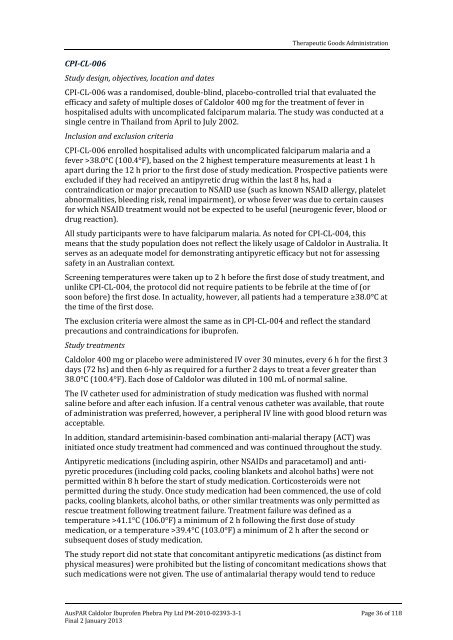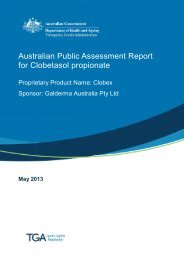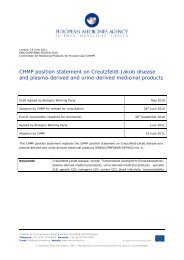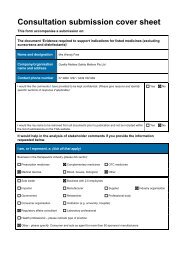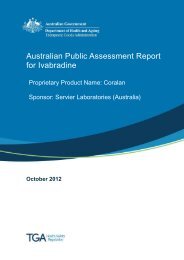Australian public assessment for Ibuprofen - Therapeutic Goods ...
Australian public assessment for Ibuprofen - Therapeutic Goods ...
Australian public assessment for Ibuprofen - Therapeutic Goods ...
You also want an ePaper? Increase the reach of your titles
YUMPU automatically turns print PDFs into web optimized ePapers that Google loves.
CPI-CL-006<br />
Study design, objectives, location and dates<br />
AusPAR Caldolor <strong>Ibuprofen</strong> Phebra Pty Ltd PM-2010-02393-3-1<br />
Final 2 January 2013<br />
<strong>Therapeutic</strong> <strong>Goods</strong> Administration<br />
CPI-CL-006 was a randomised, double-blind, placebo-controlled trial that evaluated the<br />
efficacy and safety of multiple doses of Caldolor 400 mg <strong>for</strong> the treatment of fever in<br />
hospitalised adults with uncomplicated falciparum malaria. The study was conducted at a<br />
single centre in Thailand from April to July 2002.<br />
Inclusion and exclusion criteria<br />
CPI-CL-006 enrolled hospitalised adults with uncomplicated falciparum malaria and a<br />
fever >38.0°C (100.4°F), based on the 2 highest temperature measurements at least 1 h<br />
apart during the 12 h prior to the first dose of study medication. Prospective patients were<br />
excluded if they had received an antipyretic drug within the last 8 hs, had a<br />
contraindication or major precaution to NSAID use (such as known NSAID allergy, platelet<br />
abnormalities, bleeding risk, renal impairment), or whose fever was due to certain causes<br />
<strong>for</strong> which NSAID treatment would not be expected to be useful (neurogenic fever, blood or<br />
drug reaction).<br />
All study participants were to have falciparum malaria. As noted <strong>for</strong> CPI-CL-004, this<br />
means that the study population does not reflect the likely usage of Caldolor in Australia. It<br />
serves as an adequate model <strong>for</strong> demonstrating antipyretic efficacy but not <strong>for</strong> assessing<br />
safety in an <strong>Australian</strong> context.<br />
Screening temperatures were taken up to 2 h be<strong>for</strong>e the first dose of study treatment, and<br />
unlike CPI-CL-004, the protocol did not require patients to be febrile at the time of (or<br />
soon be<strong>for</strong>e) the first dose. In actuality, however, all patients had a temperature ≥38.0°C at<br />
the time of the first dose.<br />
The exclusion criteria were almost the same as in CPI-CL-004 and reflect the standard<br />
precautions and contraindications <strong>for</strong> ibuprofen.<br />
Study treatments<br />
Caldolor 400 mg or placebo were administered IV over 30 minutes, every 6 h <strong>for</strong> the first 3<br />
days (72 hs) and then 6-hly as required <strong>for</strong> a further 2 days to treat a fever greater than<br />
38.0°C (100.4°F). Each dose of Caldolor was diluted in 100 mL of normal saline.<br />
The IV catheter used <strong>for</strong> administration of study medication was flushed with normal<br />
saline be<strong>for</strong>e and after each infusion. If a central venous catheter was available, that route<br />
of administration was preferred, however, a peripheral IV line with good blood return was<br />
acceptable.<br />
In addition, standard artemisinin-based combination anti-malarial therapy (ACT) was<br />
initiated once study treatment had commenced and was continued throughout the study.<br />
Antipyretic medications (including aspirin, other NSAIDs and paracetamol) and antipyretic<br />
procedures (including cold packs, cooling blankets and alcohol baths) were not<br />
permitted within 8 h be<strong>for</strong>e the start of study medication. Corticosteroids were not<br />
permitted during the study. Once study medication had been commenced, the use of cold<br />
packs, cooling blankets, alcohol baths, or other similar treatments was only permitted as<br />
rescue treatment following treatment failure. Treatment failure was defined as a<br />
temperature >41.1°C (106.0°F) a minimum of 2 h following the first dose of study<br />
medication, or a temperature >39.4°C (103.0°F) a minimum of 2 h after the second or<br />
subsequent doses of study medication.<br />
The study report did not state that concomitant antipyretic medications (as distinct from<br />
physical measures) were prohibited but the listing of concomitant medications shows that<br />
such medications were not given. The use of antimalarial therapy would tend to reduce<br />
Page 36 of 118


